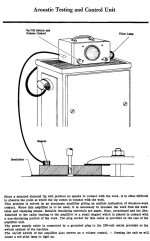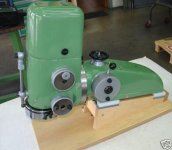Sure thing those grinding spindles need to be serviced prior to any use. I didn't figure out how to do that (propably taking them apart is involved, but as i didn't need to use them yet, i didn't bother), but i'm sure it can be done. Shouldn't take much more than a good cleaning and re-lubrication. Most interesting part will be finding the correct lube for those bearings.
I've had one of those precise grinding spindles before, but the problem of those is that they are super long (50% more length than the deckel grinding spindles are) and the one that attaches to the grinding head are hard to find. I could, however, for sure scavenge one of the mounts of the deckel grinding spindles or the centricator mount and just make it a mount for a precise spindle. But with the hauser table in place i'm running short in machine height when mounting a precise spindle.
So i'll "just" inspect and "restore" the deckel grinding spindles, and give it a shot.
I bought the machine for jig boring work in the first place, so the grinding bit isn't super important to me. BUT i've got some applications (re-grinding conrod bearing journals and crank roller bearing housings at the moment) that are much easier to do on this machine than to visit my friend with the mikromat BKoZ every couple of weeks.
Anyway, electrical setup help is what i'm asking for, maybe somebody can help me figure out the "what does what" on the controlling panel. I did figure out the VFD and test-run one of the grinding spindles (for a short time, keeping the lubrication problem in mind...)


 However, my belief is that it probably is an occassinal use type setup. I say that because the dedicated boring/jig machine (LKS) seems to be regarded as inferior to the Sip, Hauser, etc machines.
However, my belief is that it probably is an occassinal use type setup. I say that because the dedicated boring/jig machine (LKS) seems to be regarded as inferior to the Sip, Hauser, etc machines. 



